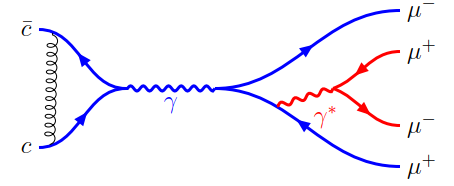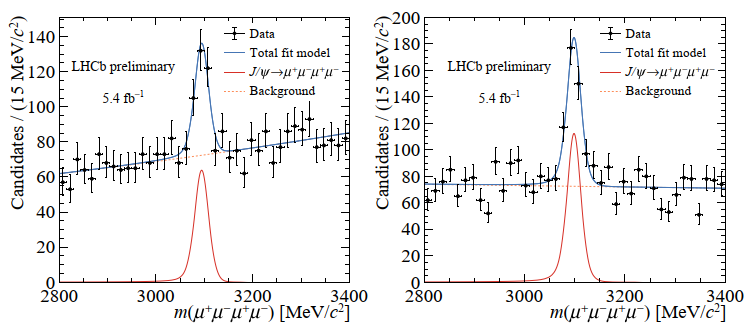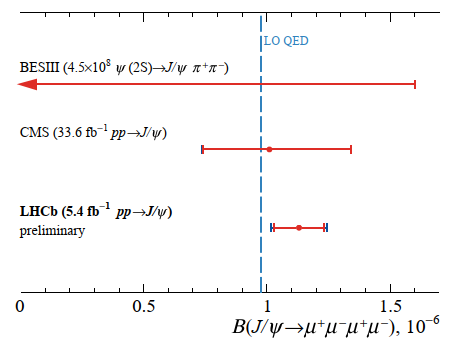Today, at the Rencontres de Moriond QCD and High Energy Interactions, the LHCb collaboration reported the observation of the rare elecromagnetic decay J/ψ→μ+μ–μ+μ–.
The simultaneous discovery of the J/ψ meson at Brookhaven and SLAC in November 1974 brought about a revolutionary change in the particle physics landscape. Prior to this revolution, in analogy to atomic and nuclear physics, it was expected that the number of quark bound states, called resonances or particles, would increase at higher energies. At higher particle masses, more and more decays would be allowed with shorter lifetimes and therefore wider mass distributions. The overlapping wide resonances would lead to a boring continuum at higher energies. The observation of the J/ψ meson, an extremely narrow resonance at high energy, was tantamount to discovery of “new physics” in today’s language and led to a fertile land of charm, beauty, top quark and τ lepton physics. Today, the J/ψ meson is one of the most studied particles. An enormous number of its decays have been documented. However, the decay into four muons has only recently been observed.
The LHCb physicists measured the branching fraction of the J/ψ→μ+μ–μ+μ– decay in two steps. In the first step, the ratio of the branching fraction of J/ψ→μ+μ–μ+μ– (4μ) to that of J/ψ→μ+μ– (2μ) was measured. In a second step, this ratio was used to determine the branching fraction of the 4μ decay using the well known branching fraction of the 2μ decay.

The figure above shows the diagram for the 4μ decay of the J/ψ meson. The virtual photon photon, indicated as γ* in the figure, can be emitted from either muon leg. The blue part of the diagram corresponds to the 2μ decay of the J/ψ meson.
The analysis is performed separately for the two dominant production mechanisms of J/ψ mesons, namely the prompt production in the LHC pp collision and the secondary production in decays of beauty hadrons. The muons from the decay of the J/ψ mesons are detected in the LHCb detector as the only charged particles that reach the “muon” chambers located between thick iron absorbers at the far end of the LHCb detector.

The images above show the invariant mass distribution for the prompt (left) and secondary (right) J/ψ→μ+μ– decays. The images below show the invariant mass distribution for the prompt (left) and secondary(right) J/ψ→μ+μ–μ+μ– decays. The number of observed events is 166±27 and 286±30 for the prompt and secondary datasets, respectively. The significance of the observed decays is well above the detection threshold.

The results from the two categories are in excellent agreement and are therefore averaged, giving the measured value of 4μ to 2μ branching fraction ratio of (1.89±0.17±0.09)x10-5, in agreement with the theoretical QED calculation. By multiplying this ratio with the known value of the 2μ branching fraction, the value of the J/ψ→μ+μ–μ+μ– branching fraction is obtained to be (1.13±0.10±0.05±0.01)x10-6.

The first observation of the J/ψ→μ+μ–μ+μ– decay was reported two weeks ago by the CMS collaboration, which showed a J/ψ mass peak for this decay with 12 signal candidates. LHCb results are more precise, benefiting from the analysis of 450 J/ψ→μ+μ–μ+μ– decays. The figure above shows the comparison of the branching fraction measurement announced today by LHCb with those of the CMS experiment and the upper limit reported previously by the BESIII experiment. The statistical uncertainties are shown in red, while the total uncertainty in blue. The leading-order QED prediction is shown as a dashed line.
Read more in the conference presentation and in the conference note.
